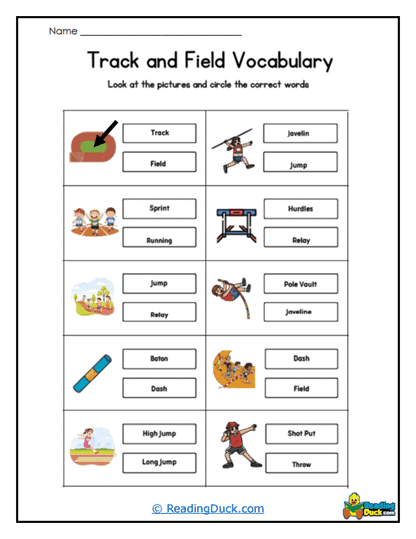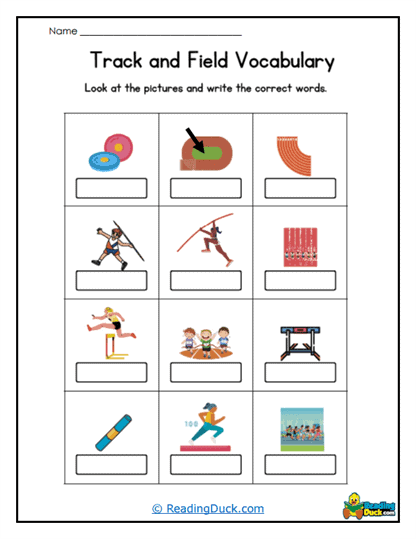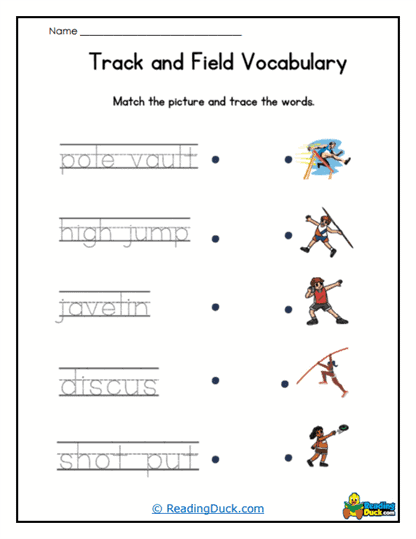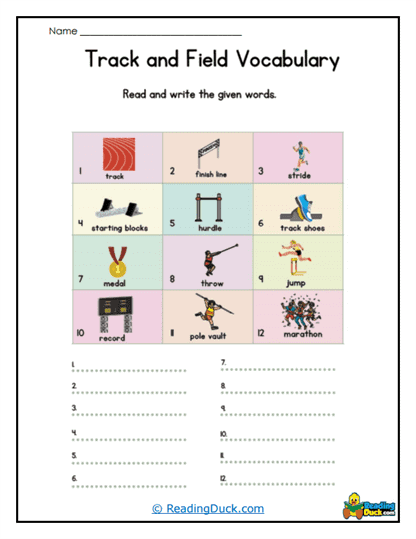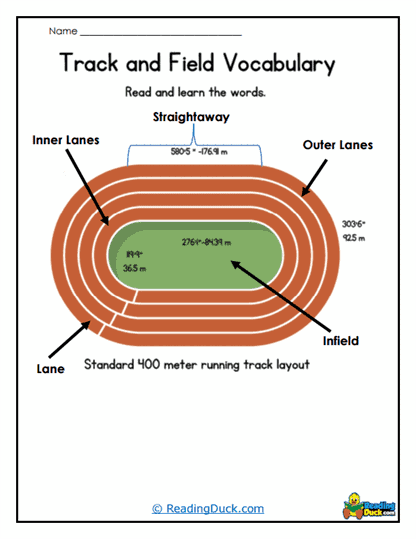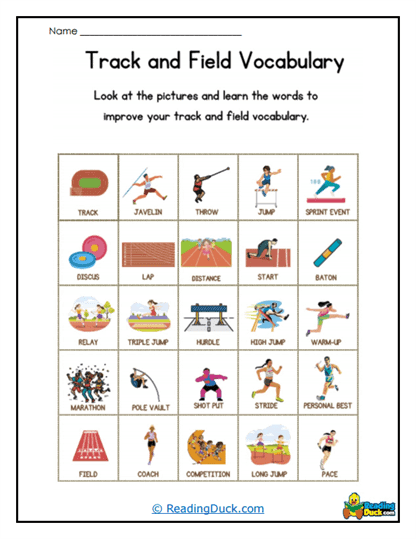Track and Field Words Worksheets
About Our Track and Field Vocabulary Word Worksheets
These worksheets will help you introduce students to the specific language of the sport of track and field. These worksheets serve as an engaging way to familiarize learners with terminology such as "relay," "hurdle," "long jump," and "baton," providing a foundation for understanding the sport's unique aspects. Whether used in classrooms or homeschooling environments, these worksheets integrate language arts skills with sports education, offering a multi-disciplinary approach to learning. By incorporating these resources, educators can enrich their curriculum with lessons that are both dynamic and relevant to students' interests.
The activities included in these sheets can range from word matching to sentence completion and context-based exercises. Word matching tasks might pair terms with their definitions or corresponding images, fostering initial word recognition and comprehension. Sentence completion exercises could prompt students to use newly learned vocabulary in meaningful contexts, solidifying their understanding and encouraging correct usage. Context-based activities, such as reading passages or scenarios involving track and field, allow students to deduce meanings from context, promoting critical thinking and interpretative skills. These varied exercises ensure that students remain engaged while catering to diverse learning styles.
For students, these worksheets are a gateway to improving their vocabulary in a fun and educational manner. By focusing on track and field-specific terms, they learn words that might otherwise remain outside their everyday lexicon. This specialized vocabulary not only enhances their knowledge of the sport but also improves their overall language abilities. For instance, learning terms like "stride" or "velocity" may lead to greater familiarity with descriptive and technical language, which can be applied in broader academic contexts. The act of acquiring and practicing these words strengthens verbal fluency and builds confidence in communicating about specialized topics.
Another key benefit is the enhancement of reading comprehension skills. Many worksheets incorporate short passages or instructions that require careful reading and interpretation. As students engage with these texts, they practice extracting key information, identifying main ideas, and drawing inferences-all critical components of strong reading skills. This aspect is particularly valuable for educators aiming to reinforce literacy while connecting it to real-world topics. Additionally, students gain a deeper appreciation for the relationship between language and its practical applications, seeing how words are used to describe movement, strategy, and competition.
Beyond academic advantages, these worksheets foster better communication skills. Whether students are discussing their favorite events, explaining rules, or narrating a fictional race, they gain experience in articulating ideas clearly and effectively. This ability is not only crucial for academic success but also valuable in everyday interactions. By equipping students with the vocabulary to describe and discuss track and field, these worksheets help them connect with peers who share similar interests, building social confidence and encouraging collaborative learning.
The Sport of Track and Field
Track and field is one of the oldest and most celebrated sports in the world, rooted in ancient history and showcasing the ultimate test of human physical capabilities. Its origins trace back to the Olympic Games of Ancient Greece, where athletes competed in events like the stadion, a short sprint that was the sole event of the first Olympic Games in 776 BCE. Today, track and field has evolved into a global phenomenon, encompassing a wide variety of events that test speed, endurance, strength, and precision. It is one of the few sports that directly measures physical feats-such as how fast, how far, and how high an individual can go-making it uniquely thrilling to both participants and spectators.
One of the most remarkable aspects of track and field is the sheer diversity of its events. From the lightning-fast 100-meter sprint, often called "the fastest race on Earth," to the grueling 10,000-meter run that demands incredible endurance, the sport spans a vast spectrum of athletic prowess. Throwing events like the shot put and javelin showcase raw power, while jumping events such as the high jump and pole vault highlight agility and precision. The decathlon and heptathlon take it to another level, requiring athletes to excel in multiple disciplines, combining speed, strength, and skill over two grueling days of competition. These events make track and field a true celebration of versatility and dedication.
The records set in track and field are often staggering and seem to defy the limits of human potential. Usain Bolt's 9.58-second world record in the 100 meters remains one of the most iconic achievements in sports history, earning him the title of "the fastest man alive." Similarly, the long jump record set by Mike Powell in 1991, with an astonishing leap of 8.95 meters, is a feat that continues to captivate fans. Beyond these incredible physical accomplishments, track and field events are a showcase of mental fortitude. Athletes train for years, enduring relentless schedules and pushing through physical and mental barriers to deliver peak performances during fleeting moments of competition.
Perhaps the most inspiring fact about track and field is its universal appeal and accessibility. Athletes from nearly every corner of the globe participate in the sport, making it one of the most inclusive disciplines in the world. From high school track meets to the grandeur of the Olympics, the sport brings people together across cultures, backgrounds, and abilities. Track and field is often the gateway to athletics for young people, offering a foundation for fitness and sportsmanship. Its emphasis on personal bests and continuous improvement teaches values of perseverance and self-discipline, proving that track and field is not just about winning but about striving for excellence in all aspects of life.
Vocabulary Words That We Cover On These Worksheets
Sprint - A sprint is a short-distance running event focused on maximum speed over a brief period. Common distances include 100 meters, 200 meters, and 400 meters. Sprinters rely on explosive power, quick reaction times, and efficient running mechanics to succeed.
Relay - A relay race is a team event where each member runs a segment of the race before passing a baton to the next runner. Coordination, timing, and seamless baton exchanges are critical for success. Popular relay events include the 4x100 meter and 4x400 meter races.
Hurdles - Hurdling involves running over a series of barriers evenly spaced along a track. Athletes must combine speed, agility, and precise timing to clear the hurdles without breaking their stride. Events include the 110-meter hurdles for men and 100-meter hurdles for women.
Long Jump - The long jump is a field event where athletes sprint down a runway and leap as far as possible into a sandpit. Success depends on speed, takeoff power, and precise timing at the jump board. The athlete's jump is measured from the edge of the takeoff board to the closest mark in the sand.
Shot Put - In the shot put, athletes throw a heavy spherical object called the "shot" as far as possible. Proper technique and explosive strength are essential to achieve maximum distance. Throws are measured from the circle where the thrower stands to the nearest point of landing.
High Jump - The high jump involves clearing a horizontal bar without knocking it down using a specialized technique like the Fosbury Flop. Athletes require a combination of speed, strength, and flexibility to generate the vertical lift needed. The height of the bar increases progressively during the competition.
Javelin - The javelin throw is a field event where athletes hurl a long, spear-like implement as far as they can. Technique and arm strength are crucial for achieving maximum distance and maintaining a legal throw. Throws are judged based on where the javelin first lands.
Pole Vault - Pole vaulting is a track and field event where athletes use a flexible pole to propel themselves over a high bar. It requires a blend of speed, technique, and upper-body strength. Athletes aim to clear progressively higher bars during the competition.
Decathlon - The decathlon is a multi-event competition for men that includes 10 track and field events over two days, testing a wide range of athletic skills. Events include sprints, jumps, throws, and distance runs. Points are awarded based on performance in each event, and the athlete with the highest total wins.
Heptathlon - The heptathlon is a multi-event competition for women that includes seven track and field events, such as sprints, jumps, and throws. Like the decathlon, athletes earn points based on their performance in each event. The winner is the competitor with the highest cumulative score.
Baton - A baton is a lightweight, hollow cylinder passed between teammates in a relay race. Proper grip and smooth exchanges are critical for maintaining speed during the transition. Dropping the baton can disqualify a team or result in a significant time penalty.
Stride - A stride refers to the length and rhythm of an athlete's steps while running. Maintaining an efficient stride is crucial for maximizing speed and conserving energy. Athletes often work on stride mechanics to improve their performance.
False Start - A false start occurs when an athlete begins a race before the starting signal is given. This is considered a violation, and the athlete may be disqualified depending on the rules. False starts often result from nervous anticipation or poor reaction timing.
Crossbar - The crossbar is the horizontal bar that athletes attempt to clear in high jump and pole vault events. It is made of lightweight material and is designed to fall easily if touched. Competitors must clear the crossbar without dislodging it to achieve a valid jump.
Velocity - Velocity refers to the speed and direction of an athlete's movement, a critical factor in track and field events. High velocity is essential in sprints, jumps, and throws to maximize performance. Athletes work on their acceleration and technique to enhance velocity effectively.

